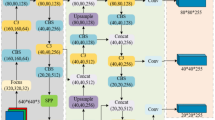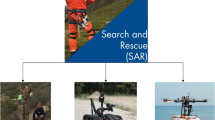Abstract
One of the important tools used by Natural Disaster Mitigation and Management (NDMM) in recent times is drone surveillance, particularly effective in disaster-affected areas. Drones equipped with modern imaging capabilities offer enhanced coverage and accessibility in disaster-affected areas, making them particularly effective in locating individuals trapped during floods and earthquakes. Traditional human-operated video analysis has limitations such as low processing speed, insufficient dataset resulting in poor performance, higher implementation cost, longer computation time, and so on. To address the traditional approach's complications posed in complex search and rescue scenarios, this paper suggest a Double Transfer Bidirectional Feature Pyramid-based YOLOv8. This innovative model leverages the Bidirectional Feature Pyramid to improve the extraction of image features through the pyramid with features at multiple scales, and uses a Double Transfer Strategy to transfer the pre-trained models to different operational environments. YOLOv8 architecture is employed due to its proven effectiveness in achieving high-speed and precise object detection under real-time constraints. These models bring a considerable enhancement of the accuracy and stability of the person detection in aerial images. Performance analysis proved that the proposed model achieves 99.68% accuracy on the 4 K Drone, which is more efficient than the current methods. Moreover, the mean inference time of the model is lower to only 0.30 ms of the total time per image, which may be considered a great improvement compared to the time-consuming traditional approaches. The evaluation process included cross-validation and testing across diverse disaster scenarios to ensure the robustness and reliability of the results. The proposed model is more accurate and with less execution time in real-time SAR applications, making it an essential tool for quick detection and leads to individuals during natural disasters. The model also enhances emergency response efforts, demonstrating its potential to save lives in critical situations.




















Similar content being viewed by others
Data availability
The data that support the findings of this study are available from the corresponding author upon reasonable request.
References
Daud SMSM, Yusof MYPM, Heo CC, Khoo LS, Singh MKC, Mahmood MS, Nawawi H (2022) Applications of drone in disaster management: a scoping review. Sci Justice 62(1):30–42
Dong J, Ota K, Dong M (2021) UAV-based real-time survivor detection system in post-disaster search and rescue operations. IEEE J Miniaturization Air Space Syst 2(4):209–219
Dousai NMK, Loncaric S (2021) Detection of humans in drone images for search and rescue operations. In: Proceedings of the 2021 3rd Asia Pacific Information Technology Conference, Bangkok Thailand. pp 69–75
Dousai NMK, Lončarić S (2022) Detecting humans in search and rescue operations based on ensemble learning. IEEE Access 10:26481–26492
Gadhave P, Chaturvedi P, Bera S, Singh A, Joseph R (2023) Post-disaster aerial image analysis using deep learning and image processing. In: International Conference on Soft Computing for Security Applications. Singapore: Springer Nature Singapore, pp 345–362
Kundid Vasić M, Papić V (2022) Improving the model for person detection in aerial image sequences using the displacement vector: a search and rescue scenario. Drones 6(1):19
Lyu M, Zhao Y, Huang C, Huang H (2023) Unmanned aerial vehicles for search and rescue: a survey. Remote Sens 15(13):3266
Martinez-Alpiste I, Golcarenarenji G, Wang Q, Alcaraz-Calero JM (2021) Search and rescue operation using UAVs: A case study. Expert Syst Appl 178:114937
Mishra B, Garg D, Narang P, Mishra V (2021) A hybrid approach for search and rescue using 3DCNN and PSO. Neural Comput Appl 33:10813–10827
Munawar HS, Ullah F, Qayyum S, Khan SI, Mojtahedi M (2021) UAVs in disaster management: application of integrated aerial imagery and convolutional neural network for flood detection. Sustainability 13(14):7547
Niedzielski T, Jurecka M, Miziński B, Pawul W, Motyl T (2021) First successful rescue of a lost person using the human detection system: a case study from Beskid Niski (SE Poland). Remote Sens 13(23):4903
Oh D, Han J (2021) Smart search system of autonomous flight UAVs for disaster rescue. Sensors 21(20):6810
Pi Y, Nath ND, Behzadan AH (2021) Detection and semantic segmentation of disaster damage in UAV footage. J Comput Civ Eng 35(2):04020063
Ramírez-Ayala O, González-Hernández I, Salazar S, Flores J, Lozano R (2023) Real-time person detection in wooded areas using thermal images from an aerial perspective. Sensors 23(22):9216
Rizk M, Slim F, Charara J (2021) Toward AI-assisted UAV for human detection in search and rescue missions. In: 2021 International Conference on Decision Aid Sciences and Application (DASA). IEEE, pp 781–786
Sahana MP, Sengar A, Dubey A, Agrawal U (2022) Person detection in maritime search and rescue operations. Int Res J Eng Tech 9(6):1383–1388
Valarmathi B, Kshitij J, Dimple R, Srinivasa Gupta N, Harold Robinson Y, Arulkumaran G, Mulu T (2023) Human detection and action recognition for search and rescue in disasters using yolov3 algorithm. J Electr Comput Eng 2023(1):5419384
Wu T, Dong Y (2023) YOLO-SE: Improved YOLOv8 for remote sensing object detection and recognition. Appl Sci 13(24):12977
Xing L, Fan X, Dong Y, Xiong Z, Xing L, Yang Y, Bai H, Zhou C (2022) Multi-UAV cooperative system for search and rescue based on YOLOv5. Int J Disaster Risk Reduction 76:102972
Zhang N, Nex F, Vosselman G, Kerle N (2022a) Training a disaster victim detection network for UAV search and rescue using harmonious composite images. Remote Sens 14(13):2977
Zhang X, Feng Y, Zhang S, Wang N, Mei S (2022b) Finding nonrigid tiny person with densely cropped and local attention object detector networks in low-altitude aerial images. IEEE J Sel Top Appl Earth Obs Remote Sens 15:4371–4385
Acknowledgements
Not applicable
Funding
Not applicable.
Author information
Authors and Affiliations
Contributions
All agreed on the content of the study. SPMS, MV and KM collected all the data for analysis. MV agreed on the methodology. SPMS, MV and KM completed the analysis based on agreed steps. Results and conclusions are discussed and written together. All authors read and approved the final manuscript.
Corresponding author
Ethics declarations
Informed consent
Informed consent was obtained from all individual participants included in the study.
Consent to participate
Not applicable.
Consent for publication
Not applicable.
Human and animal rights
This article does not contain any studies with human or animal subjects performed by any of the authors.
Competing interests
The authors declare no competing interests.
Additional information
Communicated by: Hassan Babaie
Publisher's Note
Springer Nature remains neutral with regard to jurisdictional claims in published maps and institutional affiliations.
Rights and permissions
Springer Nature or its licensor (e.g. a society or other partner) holds exclusive rights to this article under a publishing agreement with the author(s) or other rightsholder(s); author self-archiving of the accepted manuscript version of this article is solely governed by the terms of such publishing agreement and applicable law.
About this article
Cite this article
M S, S.P., Vidhyalakshmi, M. & Manivannan, K. Enhancing spatial accuracy in disaster response: a DTBiFP-YOLOv8 model for drone-based search and rescue operations. Earth Sci Inform 18, 240 (2025). https://doi.org/10.1007/s12145-025-01705-3
Received:
Accepted:
Published:
DOI: https://doi.org/10.1007/s12145-025-01705-3




